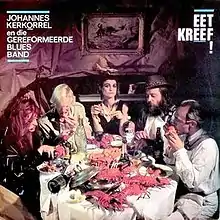| Eet Kreef | ||||
|---|---|---|---|---|
 | ||||
| Studio album by | ||||
| Released | 1989 | |||
| Genre | Rock music | |||
| Label | Shifty | |||
| Producer | Lloyd Ross | |||
| Johannes Kerkorrel chronology | ||||
| ||||
Eet Kreef is the first studio album by Johannes Kerkorrel and the Gereformeerde Blues Band. Released in 1989 on the now-defunct Shifty Records label, the album was a commercial success despite its tracks being banned from radio airplay by the South African Broadcasting Corporation.[1][2]
Track listing
All tracks written by Johannes Kerkorrel, unless otherwise noted.
- Sit Dit Af
- Tronk
- Liefde
- Ossewa
- Hillbrow
- Donker Donker Land
- Energie
- BMW (Kerkorrel/Daggadirk Uys, Andre le Toit)
- Ou Ou Lied Van Afrika (Mariaan de Jong)
Personnel
- Johannes Kerkorrel – vocals, keyboards
- Willem "Meneer Volume" Möller – guitar
- Gary "Piet Pers" Herselman – bass
- Jannie "Hanepoot" van Tonder – drums, trombone
- Additional musicians
- Antoinette Butler – voice on Sit Dit Af
- Ian Herman – drums
- Louis Tros – synths, acoustic guitar
- Shaun Naidoo – synths
- Warrick Sony – finger cymbals
References
- ↑ "Voëlvry". Shifty. Archived from the original on 29 October 2013. Retrieved 22 April 2013.
Ralph Rabie, who was at that time a journalist on an Afrikaans paper, went down to Cape Town to interview André when Vêr van die ou Kalahari was released. There was a meeting of minds which eventually led to both of them playing in the first incarnation of the Gereformeerde Blues Band. A short while later, André left to forge a solo career as Koos Kombuis, while Ralph, by then known as Johannes Kerkorrel, went on to record the seminal Eet Kreef album with the remaining members of the GBB. Both artists featured on the Voëlvry compilation, which came out around this time.
- ↑ "Johannes Kerkorrel & GBB". Shifty. Retrieved 22 April 2013.
Slashing their way out of the Nationalist Party ideology, the GBB charted the wide open spaces of a new Afrikaner rebellion. This time the insurrection was a musical one, with the GBB as rock & roll outlaws slinging guitars and stinging criticism against the laager mentality of volks kultuur and the apartheid way of life. Moving conventional rock into the realm of political theatre and satire as successfully as they did proved that if the GBB were to be seen as cultural upstarts, they were upstarts with a vision both innovative and lucid that could not be ignored.
This article is issued from Wikipedia. The text is licensed under Creative Commons - Attribution - Sharealike. Additional terms may apply for the media files.